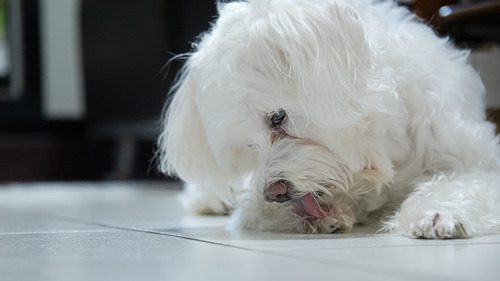Dog Yeast Infection in Paws
If your dog has been licking, chewing, or biting at their paws nonstop, you may have noticed a strong odor, redness, or brown discharge between the toes. These uncomfortable symptoms often point to a dog yeast infection in paws, a common but frustrating condition that can make walking and playtime painful. Because paw problems are one of the most frequent reasons pet parents call the vet, it’s worth learning what yeast infections in paws mean for your dog, what signs to look for, and how our veterinary team can help. At Cornerstone Veterinary Hospital of Saratoga Springs, we see many cases of dogs having a yeast infection in their paws, and we know how uncomfortable it can be for your pet. If your dog is showing symptoms, call us at (518) 691-3300 or schedule an appointment today.

What Is a Dog Yeast Infection in Paws?
A dog yeast infection in paws occurs when yeast, which normally lives on your dog’s skin in small amounts, grows out of balance. Yeast thrives in warm, moist environments, and a dog’s paws often provide the perfect conditions, especially between the toes or under the paw pads.
How Yeast Affects the Skin
- Yeast organisms multiply rapidly when conditions are right.
- The overgrowth leads to inflammation, causing redness and swelling.
- Dogs may chew or lick excessively, making the irritation worse.
- Over time, skin may thicken, darken, or develop a greasy texture.
Since yeast naturally lives on the skin, a dog yeast infection in paws doesn’t mean your pet has poor hygiene. Instead, it usually signals an underlying condition that allows yeast to grow unchecked.
Signs of Dog Yeast Infection in Paws
Recognizing the symptoms of a dog yeast infection in paws is the first step to getting your dog relief. Because the signs often resemble other paw conditions, veterinary evaluation is always important.
Common Symptoms Pet Owners Notice
- Persistent licking, chewing, or biting at the paws
- Redness and swelling between the toes
- A strong, musty odor from the paws
- Brown discharge or greasy build-up
- Darkened, thickened, or flaky skin around paw pads
- Sensitivity when touched, leading to limping or reluctance to walk
If your dog shows several of these signs, a dog yeast infection in paws may be the cause. Early treatment from your veterinarian can prevent the infection from worsening and reduce discomfort.
Causes of Dog Yeast Infection in Paws
Yeast overgrowth in a dog’s paws rarely happens without a reason. Understanding the root causes helps you see why this condition often returns if the underlying issue isn’t addressed.
Environmental Triggers
Moisture is one of the most common contributors. Dogs who walk in wet grass, snow, or rain may develop damp paws that never fully dry, creating the perfect environment for yeast. Hot, humid climates also increase the likelihood of infection.
Medical Conditions
Some dogs have medical factors that make them more prone to yeast infections:
- Allergies: Food or environmental allergies often cause paw licking, which increases moisture and irritation.
- Hormonal imbalances: Conditions like hypothyroidism can affect skin health.
- Weakened immune system: A dog with immune issues may struggle to control normal yeast levels.
Because multiple causes may overlap, veterinary diagnosis is key to identifying why a dog yeast infection in paws has developed.
How Veterinarians Diagnose Dog Yeast Infection in Paws
When you bring your dog to Cornerstone Veterinary Hospital of Saratoga Springs, our team uses a combination of physical exams and laboratory tests to confirm yeast infection in paws.
Diagnostic Steps
- Visual examination: Looking for redness, odor, or discharge between the toes.
- Cytology testing: Collecting a sample from the paw to view yeast cells under a microscope.
- Skin scrapings: To rule out parasites or bacterial infections.
- Reviewing medical history: Understanding allergies, diet, or past infections to see possible triggers.
These steps allow us to confirm if yeast is the true cause, or if another condition such as bacteria or mites is behind your dog’s discomfort.
Why Prompt Treatment Matters
A dog yeast infection in paws may start as mild irritation, but it can quickly escalate if left untreated. Constant licking and chewing can lead to open sores, secondary bacterial infections, and significant pain.
Risks of Ignoring Symptoms
- Spread of yeast infection to other areas like ears or skin folds
- Chronic inflammation that thickens and darkens the skin
- Increased difficulty in walking or standing comfortably
- Higher treatment costs and longer recovery times
Getting veterinary help early allows your pet to recover faster and return to their normal, active lifestyle.
Tips for Preventing Dog Yeast Infection in Paws
Once your veterinarian has addressed the infection, preventing future flare-ups is often the next goal. Because yeast thrives under certain conditions, reducing those triggers is the best long-term strategy.
- Keep Paws Dry and Clean: Dogs who spend time outdoors can track in moisture, dirt, and allergens. Routine paw checks and gentle cleaning after walks help reduce the environment yeast loves.
- Support Overall Health: Balanced nutrition, regular checkups, and allergy management all play a role in reducing yeast overgrowth. If your dog has chronic allergies or medical conditions, your veterinarian can recommend strategies that lessen paw infections over time.
- Work With Your Veterinary Team: Every dog is different, and what causes a yeast infection in one dog may not affect another. Your veterinarian can tailor prevention steps to your dog’s unique needs and lifestyle.
When to Call Cornerstone Veterinary Hospital of Saratoga Springs
If your dog is constantly licking their paws, has a strong odor coming from their feet, or seems uncomfortable walking, it may be more than just irritation. It could be a dog yeast infection in paws. Our team at Cornerstone Veterinary Hospital of Saratoga Springs can help your pet find relief and get back to feeling comfortable. Call us today at (518) 691-3300. The sooner we see your dog, the sooner we can identify the cause and provide the care they need.
Recent Posts
Why is My Male Cat Peeing Everywhere and Meowing So Much?
Why is My Male Cat Peeing Everywhere and Meowing So Much? If your male cat is suddenly…
Cat Skin Infections: Symptoms & Treatment
Cat Skin Infections: Symptoms & Treatment Cats are known for their meticulous grooming habits, but when persistent…
Can a Dog Have Sleep Apnea?
Can a Dog Have Sleep Apnea? Sleep apnea is a condition commonly associated with humans, but can…
- « Previous
- 1
- 2
- 3
- 4
- Next »
About Us
Originally opened as Animal Care Hospital by Dr. Mark Johnston in 1989, the hospital became Cornerstone Veterinary Hospital in 2015 when it was purchased by Drs. Alan and Lisa Knott. The name 'Cornerstone' holds a special place in their hearts, representing not only their Christian faith but also their commitment to being the cornerstone of the community in which they practice. As a family-owned and operated practice, every pet is treated as part of the family, ensuring they receive the highest standard of care. The team at Cornerstone Veterinary Hospital is dedicated to building lasting relationships with clients and their beloved pets, striving to be the cornerstone of the community in which they practice.



